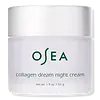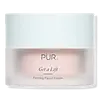What's inside
What's inside
 Key Ingredients
Key Ingredients

 Benefits
Benefits

 Concerns
Concerns

 Ingredients Side-by-side
Ingredients Side-by-side

Water
Skin ConditioningButyrospermum Parkii Butter
Skin ConditioningGlycerin
HumectantCoco-Caprylate/Caprate
EmollientDiheptyl Succinate
EmollientPropanediol
SolventCapryloyl Glycerin/Sebacic Acid Copolymer
Skin ConditioningCetearyl Olivate
Squalane
EmollientCetyl Stearate
EmollientHydrogenated Starch Hydrolysate
HumectantMacadamia Ternifolia Seed Oil
EmollientSorbitan Olivate
EmulsifyingBehenyl Alcohol
EmollientCarthamus Tinctorius Seed Oil
MaskingMyristyl Myristate
EmollientAphanizomenon Flos-Aquae Extract
HumectantCocoyl Hydrolyzed Collagen
CleansingAvena Sativa Kernel Flour
AbrasiveAndrographis Paniculata Leaf Extract
AstringentCistus Incanus Flower/Leaf/Stem Extract
Skin ConditioningLavandula Hybrida Extract
EmollientTriheptanoin
Skin ConditioningOryza Sativa Bran Extract
Skin ConditioningRosmarinus Officinalis Leaf Extract
AntimicrobialHelianthus Annuus Extract
EmollientTocopherol
AntioxidantMusa Sapientum Fruit Extract
Skin ConditioningHedera Helix Extract
AntimicrobialZiziphus Jujuba Fruit Extract
Skin ConditioningMelia Azadirachta Flower Extract
Skin ConditioningCoccinia Indica Fruit Extract
Skin ConditioningLavandula Angustifolia Oil
MaskingSodium Hydroxide
BufferingPotassium Sorbate
PreservativeCaprylhydroxamic Acid
Citric Acid
BufferingTrisodium Ethylenediamine Disuccinate
Xanthan Gum
Emulsifying1,2-Hexanediol
Skin ConditioningPhenoxyethanol
PreservativePhenylpropanol
MaskingParfum
MaskingLinalool
PerfumingLimonene
PerfumingCitral
PerfumingGeraniol
PerfumingWater, Butyrospermum Parkii Butter, Glycerin, Coco-Caprylate/Caprate, Diheptyl Succinate, Propanediol, Capryloyl Glycerin/Sebacic Acid Copolymer, Cetearyl Olivate, Squalane, Cetyl Stearate, Hydrogenated Starch Hydrolysate, Macadamia Ternifolia Seed Oil, Sorbitan Olivate, Behenyl Alcohol, Carthamus Tinctorius Seed Oil, Myristyl Myristate, Aphanizomenon Flos-Aquae Extract, Cocoyl Hydrolyzed Collagen, Avena Sativa Kernel Flour, Andrographis Paniculata Leaf Extract, Cistus Incanus Flower/Leaf/Stem Extract, Lavandula Hybrida Extract, Triheptanoin, Oryza Sativa Bran Extract, Rosmarinus Officinalis Leaf Extract, Helianthus Annuus Extract, Tocopherol, Musa Sapientum Fruit Extract, Hedera Helix Extract, Ziziphus Jujuba Fruit Extract, Melia Azadirachta Flower Extract, Coccinia Indica Fruit Extract, Lavandula Angustifolia Oil, Sodium Hydroxide, Potassium Sorbate, Caprylhydroxamic Acid, Citric Acid, Trisodium Ethylenediamine Disuccinate, Xanthan Gum, 1,2-Hexanediol, Phenoxyethanol, Phenylpropanol, Parfum, Linalool, Limonene, Citral, Geraniol
Water
Skin ConditioningCyclopentasiloxane
EmollientGlycerin
HumectantButylene Glycol
HumectantCetyl Ethylhexanoate
EmollientDimethicone
EmollientCaprylyl Methicone
Skin ConditioningPEG-10 Dimethicone
Skin ConditioningStearyl Dimethicone
EmollientDipropylene Glycol
HumectantMedicago Sativa Extract
TonicHydrolyzed Wheat Protein
Skin ConditioningHydrolyzed Manihot Esculenta Tuber Extract
Skin ConditioningCitrus Aurantium Amara Peel Oil
Skin ConditioningLavandula Angustifolia Oil
MaskingDisteardimonium Hectorite
StabilisingPolymethyl Methacrylate
Cetyl PEG/PPG-10/1 Dimethicone
EmulsifyingMagnesium Sulfate
Sclerotium Gum
Emulsion StabilisingBis-Vinyl Dimethicone/Dimethicone Copolymer
Emulsion StabilisingCitric Acid
BufferingCI 77891
Cosmetic ColorantTin Oxide
AbrasiveSodium Citrate
BufferingSynthetic Fluorphlogopite
Phenoxyethanol
PreservativeCaprylyl Glycol
EmollientDisodium EDTA
Water, Cyclopentasiloxane, Glycerin, Butylene Glycol, Cetyl Ethylhexanoate, Dimethicone, Caprylyl Methicone, PEG-10 Dimethicone, Stearyl Dimethicone, Dipropylene Glycol, Medicago Sativa Extract, Hydrolyzed Wheat Protein, Hydrolyzed Manihot Esculenta Tuber Extract, Citrus Aurantium Amara Peel Oil, Lavandula Angustifolia Oil, Disteardimonium Hectorite, Polymethyl Methacrylate, Cetyl PEG/PPG-10/1 Dimethicone, Magnesium Sulfate, Sclerotium Gum, Bis-Vinyl Dimethicone/Dimethicone Copolymer, Citric Acid, CI 77891, Tin Oxide, Sodium Citrate, Synthetic Fluorphlogopite, Phenoxyethanol, Caprylyl Glycol, Disodium EDTA
 Reviews
Reviews

Alternatives
Ingredients Explained
These ingredients are found in both products.
Ingredients higher up in an ingredient list are typically present in a larger amount.
Citric Acid is an alpha hydroxy acid (AHA) naturally found in citrus fruits like oranges, lemons, and limes.
Like other AHAs, citric acid can exfoliate skin by breaking down the bonds that hold dead skin cells together. This helps reveal smoother and brighter skin underneath.
However, this exfoliating effect only happens at high concentrations (20%) which can be hard to find in cosmetic products.
Due to this, citric acid is usually included in small amounts as a pH adjuster. This helps keep products slightly more acidic and compatible with skin's natural pH.
In skincare formulas, citric acid can:
While it can provide some skin benefits, research shows lactic acid and glycolic acid are generally more effective and less irritating exfoliants.
Most citric acid used in skincare today is made by fermenting sugars (usually from molasses). This synthetic version is identical to the natural citrus form but easier to stabilize and use in formulations.
Read more about some other popular AHA's here:
Learn more about Citric AcidGlycerin is already naturally found in your skin. It helps moisturize and protect your skin.
A study from 2016 found glycerin to be more effective as a humectant than AHAs and hyaluronic acid.
As a humectant, it helps the skin stay hydrated by pulling moisture to your skin. The low molecular weight of glycerin allows it to pull moisture into the deeper layers of your skin.
Hydrated skin improves your skin barrier; Your skin barrier helps protect against irritants and bacteria.
Glycerin has also been found to have antimicrobial and antiviral properties. Due to these properties, glycerin is often used in wound and burn treatments.
In cosmetics, glycerin is usually derived from plants such as soybean or palm. However, it can also be sourced from animals, such as tallow or animal fat.
This ingredient is organic, colorless, odorless, and non-toxic.
Glycerin is the name for this ingredient in American English. British English uses Glycerol/Glycerine.
Learn more about GlycerinLavandula Angustifolia Oil is more commonly known as lavender essential oil. It is considered a fragrancing ingredient.
Lavender imparts a famous scent. While the smell is lovely, this ingredient and may sensitize skin in topical products. This is because about 85% of the oil is made up of linalool and linalyl acetate.
When exposed to air, these two compounds become strong allergens. This ingredient exhibits cytotoxicity at low concentrations; amounts of 0.25% have been shown to damage skin cells.
A study from Japan found this ingredient caused lavender sensitivity after widespread exposure.
Lavender essential oil has some antimicrobial, antibacterial, and anti-inflammatory properties. However, the cons of this ingredient may outweight the pros.
More research is needed to confirm lavender essential oil's effects when used in aromatherapy.
Lavandula Angustifolia is known as the English Lavender and famous for creating purple fields in Provence, France.
Learn more about Lavandula Angustifolia OilPhenoxyethanol is a preservative that has germicide, antimicrobial, and aromatic properties. Studies show that phenoxyethanol can prevent microbial growth. By itself, it has a scent that is similar to that of a rose.
It's often used in formulations along with Caprylyl Glycol to preserve the shelf life of products.
Water. It's the most common cosmetic ingredient of all. You'll usually see it at the top of ingredient lists, meaning that it makes up the largest part of the product.
So why is it so popular? Water most often acts as a solvent - this means that it helps dissolve other ingredients into the formulation.
You'll also recognize water as that liquid we all need to stay alive. If you see this, drink a glass of water. Stay hydrated!
Learn more about Water